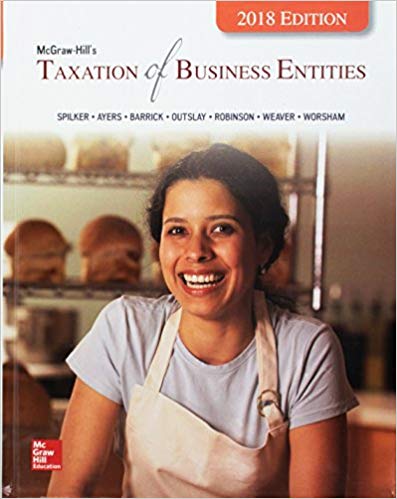Carrie DLake, Reed A. Green, and Doug A. Divot share a passion for golf and decide to go into the golf club manufacturing business together.
Carrie D’Lake, Reed A. Green, and Doug A. Divot share a passion for golf and decide to go into the golf club manufacturing business together. On January 2, 2016, D’Lake, Green, and Divot form the Slicenhook Partnership, a general partnership. Slicenhook’s main product will be a perimeter-weighted titanium driver with a patented graphite shaft. All three partners plan to actively participate in the business. The partners contribute the following property to form Slicenhook:
| Partner | Contribution | ||
| Carrie D’Lake | Land, FMV | $ | 460,000 |
| Basis $460,000, Mortgage | $ | 60,000 | |
| Reed A. Green | $ | 400,000 | |
| Doug A. Divot | $ | 400,000 | |
Carrie had recently acquired the land with the idea that she would contribute it to the newly formed partnership. The partners agree to share in profits and losses equally. Slicenhook elects a calendar-year-end and the accrual method of accounting.
In addition, Slicenhook received a $1,500,000 recourse loan from BigBank at the time the contributions were made. Slicenhook uses the proceeds from the loan and the cash contributions to build a state-of-the-art manufacturing facility ($1,200,000), purchase equipment ($600,000), and produce inventory ($400,000). With the remaining cash, Slicenhook invests $45,000 in the stock of a privately owned graphite research company and retains $55,000 as working cash.
Slicenhook operates on a just-in-time inventory system so it sells all inventory and collects all sales immediately. That means that at the end of the year, Slicenhook does not carry any inventory or accounts receivable balances. During 2016, Slicenhook has the following operating results:
| Sales | $ | 1,126,000 | ||||||||||||||||||||||||||||||||||||||||||||||||||||||||||||||||||||||||||||||||||||||||||||||||||||||||||||||||||||||||||||||||||||||||||||||||||||||||||||||||||||||||||
| Cost of goods sold | 400,000 | |||||||||||||||||||||||||||||||||||||||||||||||||||||||||||||||||||||||||||||||||||||||||||||||||||||||||||||||||||||||||||||||||||||||||||||||||||||||||||||||||||||||||||
| Interest income from tax-exempt bonds | 900 | |||||||||||||||||||||||||||||||||||||||||||||||||||||||||||||||||||||||||||||||||||||||||||||||||||||||||||||||||||||||||||||||||||||||||||||||||||||||||||||||||||||||||||
| Qualified dividend income from stock | 1,500 | |||||||||||||||||||||||||||||||||||||||||||||||||||||||||||||||||||||||||||||||||||||||||||||||||||||||||||||||||||||||||||||||||||||||||||||||||||||||||||||||||||||||||||
| Operating expenses | 126,000 | |||||||||||||||||||||||||||||||||||||||||||||||||||||||||||||||||||||||||||||||||||||||||||||||||||||||||||||||||||||||||||||||||||||||||||||||||||||||||||||||||||||||||||
| Depreciation (tax) | ||||||||||||||||||||||||||||||||||||||||||||||||||||||||||||||||||||||||||||||||||||||||||||||||||||||||||||||||||||||||||||||||||||||||||||||||||||||||||||||||||||||||||||
| §179 on equipment | $ | 39,000 | ||||||||||||||||||||||||||||||||||||||||||||||||||||||||||||||||||||||||||||||||||||||||||||||||||||||||||||||||||||||||||||||||||||||||||||||||||||||||||||||||||||||||||
| Equipment | 81,000 | |||||||||||||||||||||||||||||||||||||||||||||||||||||||||||||||||||||||||||||||||||||||||||||||||||||||||||||||||||||||||||||||||||||||||||||||||||||||||||||||||||||||||||
| Building | 24,000 | 144,000 | ||||||||||||||||||||||||||||||||||||||||||||||||||||||||||||||||||||||||||||||||||||||||||||||||||||||||||||||||||||||||||||||||||||||||||||||||||||||||||||||||||||||||||
| Interest expense on debt | 120,000 | |||||||||||||||||||||||||||||||||||||||||||||||||||||||||||||||||||||||||||||||||||||||||||||||||||||||||||||||||||||||||||||||||||||||||||||||||||||||||||||||||||||||||||
The partnership is very successful in its first year. The success allows Slicenhook to use excess cash from operations to purchase $15,000 of tax-exempt bonds (you can see the interest income already reflected in the operating results). The partnership also makes a principal payment on its loan from Big Bank in the amount of $300,000 and a distribution of $100,000 to each of the partners on December 31, 2016.
The operating expenses include a $1,800 trucking fine that one of its drivers incurred for reckless driving and speeding and meals and entertainment expense of $6,000.
Carrie and Doug propose that Slicenhook distribute the following to Reed in complete liquidation of his partnership interest:
b. What is each partner’s initial tax basis in Slicenhook on January 2, 2016?
| ||||||||||||||||||||||||||||||||||||||||||||||||||||||||||||||||||||||||||||||||||||||||||||||||||||||||||||||||||||||||||||||||||||||||||||||||||||||||||||||||||||||||||||
c. Prepare Slicenhook’s opening tax basis balance sheet as of January 2, 2016.
| |||||||||||||||||||||||||
d. Using the operating results, what are Slicenhook’s ordinary income and separately stated items for 2016 and 2017? What amount of Slicenhook’s income for each period would each of the partner’s receive?
| |||||||||||||||||||||||||||||||||||||||||||||||||||||||||||||||||||||||||||||||||
f. What are Carrie’s, Reed’s, and Doug’s bases in their partnership interest at the end of 2016 and 2017?
|
g-1. If Reed sells his interest in Slicenhook to Indie Ruff, what is the amount and character of his recognized gain or loss?
| $102,100 Ordinary income and $89,000 capital gains | ||||||||||||||||||||||||||||||||||||||||||||||||
| $102,400 Ordinary income and $90,000 capital loss | ||||||||||||||||||||||||||||||||||||||||||||||||
| $162,400 capital loss and $89,000 ordinary income | ||||||||||||||||||||||||||||||||||||||||||||||||
| $89,000 Ordinary income and $102,400 capital gains | ||||||||||||||||||||||||||||||||||||||||||||||||
Neither gain nor loss recognized g-2. What is Indie’s basis in the partnership interest?
h-1. If Reed sells his interest in Slicenhook to Indie Ruff, what is Indie's inside basis in Slicenhook?
h-2. What effect would a §754 election have on Indie’s inside basis?
i-1. If Slicenhook distributes the assets proposed by Carrie and Doug in complete liquidation of Reed’s partnership interest, what is the amount and character of Reed’s recognized gain or loss?
j-1. If Reed sells his interest, what is his after-tax cash? Assume his ordinary marginal tax rate is 35% and his capital gains tax rate is 15%.
e-1. Using the information provided, prepare Slicenhook’s tax form 1065 for 2016. Download the Tax Form and enter the required values in the appropriate fields. Please right click, and select open form in new window. Save your completed Tax Form to your computer and then upload it here by clicking "Browse." Next, click "Save." Use 2016 tax rules regardless of year on form. e-2. Using the information provided, prepare a Schedule K-1 for Carrie. Download the Tax Form and enter the required values in the appropriate fields. Please right click, and select open form in new window. Save your completed Tax Form to your computer and then upload it here by clicking "Browse." Next, click "Save." Use 2016 tax rules regardless of year on form. |
Step by Step Solution
There are 3 Steps involved in it
Step: 1

See step-by-step solutions with expert insights and AI powered tools for academic success
Step: 2

Step: 3

Ace Your Homework with AI
Get the answers you need in no time with our AI-driven, step-by-step assistance
Get Started


